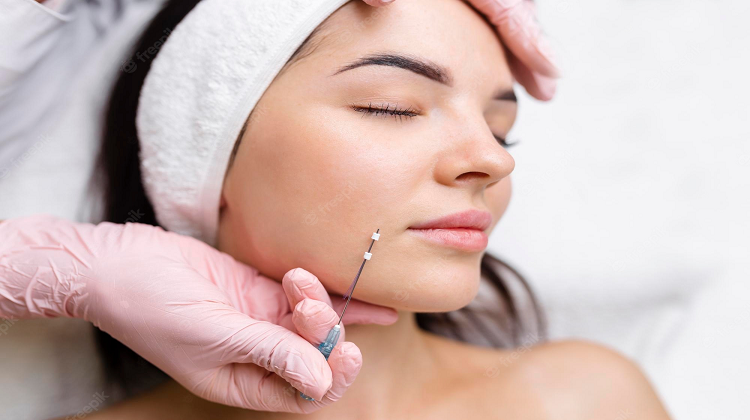Thread lifts are the latest and greatest trend in facial rejuvenation, offering a safe and minimally invasive way to look younger and more refreshed. As more and more people are turning to thread lifts for a quick fix, it has become essential to understand when and why you should get one. This definitive guide to thread lifts will provide you with the information you need to make an informed decision. We will explore the different types of thread lifts available, the risks and benefits, and the ideal candidates for this innovative procedure. With this comprehensive guide, you can be confident that you are making the best decision for your unique situation. So, if you’re considering a thread lift, read on to find out everything you need to know.
What is a thread lift?
A thread lift is one of the most minimally invasive procedures for facial rejuvenation. It is also known as a “facial suspension procedure” or “facial threading”. A thread lift uses a polyethylene thread to lift and reposition the facial tissues. This is done by removing the excess skin and then pulling the remaining tissue up to the desired position using the thread. The thread is carefully knotted at the base of the skin to secure the repositioned tissue in place. The procedure is usually done under local anesthesia. While the thread will usually dissolve in time, the results of a thread lift are long lasting. In most cases, a thread lift is used to lift and reposition the cheeks, the area around the mouth, and the upper eyelids. It is also used to augment the lips. A thread lift is a great option for those who want to look years younger but don’t want to undergo a more invasive procedure such as a facelift or a brow lift.
Types of thread lifts
There are two different types of thread lifts: endoscopic and open. Endoscopic thread lifts are the latest technological development and are minimally invasive. The advantage of an endoscopic thread lift is that it does not require a large incision on the face. Open thread lifts, on the other hand, require a small incision around the mouth or nose.
Benefits and risks of thread lifts
The advantages of a thread lift are numerous: It is quick, easy, safe, and minimally invasive. It doesn’t require any stitches and has minimal discomfort. The results are usually very natural: the facial muscles and other structures aren’t disturbed, so there is no change in the shape of the face. The procedure can be done under local anesthesia, so there is no pain. A thread lift is a great option if you want to look years younger but don’t want to undergo a more invasive procedure such as a facelift or a brow lift. There are, however, a few risks associated with a thread lift as well. The most common side effect is redness and swelling, which is expected and will subside within a few days. Occasionally, the swelling could last for a few weeks. In rare cases, the thread could break, resulting in a small hole in the skin that would need to be surgically repaired.
Ideal candidates for thread lifts
The best candidates for a thread lift are those who want to look younger but don’t want to undergo a more invasive procedure. People who have loose and sagging skin around the mouth, cheeks, and chin but don’t want to undergo a facelift or brow lift, are the best candidates for a thread lift. As a rule of thumb, you are most likely a good candidate if you are in good health, are between 30 and 80 years of age, and have good skin elasticity.
Preparing for a thread lift
As with any procedure, it’s important to prepare for a thread lift. Make sure you are healthy and don’t have any conditions that could interfere with the healing process. You might want to consider consulting with a physician beforehand to make sure you don’t have any health conditions that could interfere with the healing process. Keep in mind that the thread lift procedure is not recommended for patients with keloid scars or open wounds. You will also need to avoid ingesting aspirin, ibuprofen, and other blood-thinning medications. It’s also important to prepare your skin beforehand. You will need to stop using any retinol or glycolic products a few weeks before the procedure. Your skin will also need to be clean and free of makeup.
Thread lift recovery
The procedure itself takes less than 30 minutes. After the procedure, you will need to rest for a day or so and avoid strenuous activity for about a week. You will also be given antibiotics to prevent infection. During the first few days, you will be given compression garments to apply pressure to the treated areas. This will help reduce swelling and speed up the healing process. You may experience redness and swelling, as well as minor pain for a few days after the procedure. You may also feel numbness and tingling. These side effects should disappear within a few weeks.
Cost of thread lifts
The cost of a thread lift will vary depending on the location and experience of the surgeon. The average cost of a thread lift surgery is around $5,000-8,000. It is important to do your research and find a board-certified facial plastic surgeon who specializes in thread lifts. Ultimately, the cost of a thread lift is a small price to pay for a younger and fresher look. It’s also important to note that thread lifts are often covered by both private insurance and Medicare. Because each insurance policy is different, it’s best to check with your insurance provider beforehand.
Alternatives to thread lifts
There are a few other procedures that can be used to treat sagging skin and laugh lines. One procedure that is often used as an alternative to a thread lift is an endoscopic brow lift. This procedure is similar to a thread lift but is performed on the brow region. Like a thread lift, an endoscopic brow lift is minimally invasive and doesn’t require a large incision. The only difference is that a brow lift uses an endoscopic device to lift the brow. Another alternative procedure is a mini facelift. This procedure is a bit more invasive than a thread lift but can be very effective in treating sagging skin and laugh lines.
Aftercare tips
All of the above notwithstanding, remember that there is no such thing as a quick fix when it comes to aging. You might experience some initial improvement following the procedure, but it will take a long time before you see the final results. The best way to achieve a lasting result is by maintaining a healthy lifestyle. This means eating a healthy diet, staying hydrated, and getting enough sleep. It’s also important to exercise regularly to improve your overall health and well-being. Lastly, make sure you protect your skin from the sun and use daily sunscreen. These little steps will go a long way in helping you look years younger.
Q&A with a specialist
As you can see, a thread lift is a great option for those who want to look younger but don’t want to undergo a more invasive procedure like a facelift or brow lift. Dr. Mark Casalaso is a board-certified facial plastic surgeon who specializes in thread lifts. We sat down with him to get his insight on when and why you should get a thread lift.



